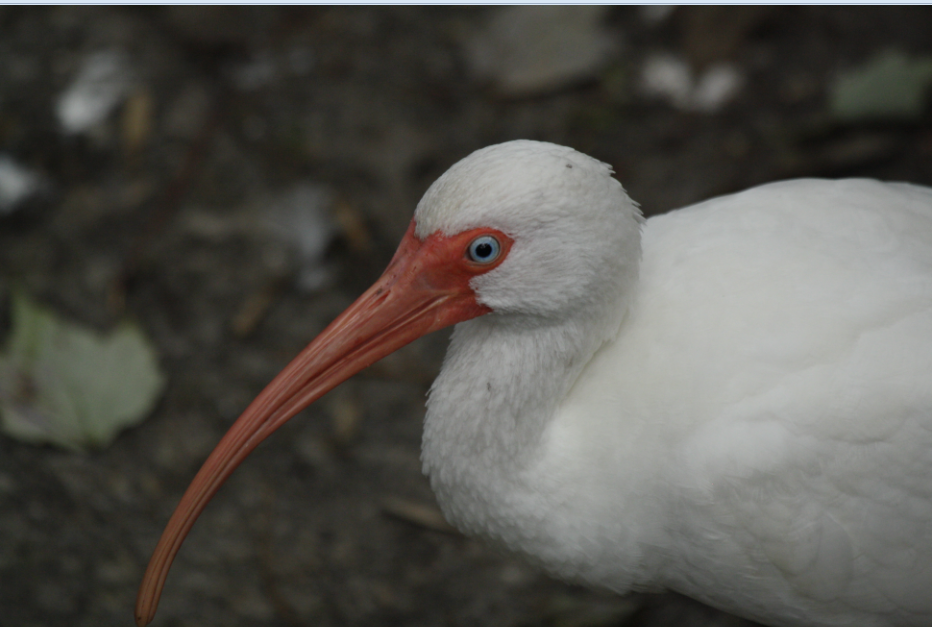A few birds common to the east I once saw in Alberta several years ago. Blue jays, with their rather variable dialect, is the best example. Then there are the 5% of birds which remain indifferent, for instance mockingbirds are just as prevalent and regular here as in the west, it has no plumage differences, sounds no different, and occupies the same (or equivalent) habitat.
The first new bird of the state was a regular garden bird, the northern cardinal.
 |
| Unfortunately it sat against the sun, and let's not even talk about the focus. |
A visit to Homosassa Springs was the first official outing in Florida. From the car park I watched this soaring anhinga, an odd cousin to the more familiar cormorants:
A little boat ride through some narrow rivers stood between us and Homosassa Springs Park. On the way it seemed few people were interested in these duckweeds. In the UK only one type is common, so it is interesting to see multiple together:
 |
| There are 3-4 different leaf types in this image, thus 3-4 different species of duckweeds. How many can you see? |
 |
| *crickets* |
 |
| Lotsa colours. |
In the trees surrounding, I picked out a blue-headed vireo. I was trying to turn it into a plumbeous unsuccessfully. Didn't realize blue-headed vireos were so dull in the head. On one of the lakes was this male anhinga:
 |
| Great egret top left. |
Another prevalent bird in Florida, even more so than in California, was the turkey vulture. However the bird of interest for this paragraph is the related black vulture, a bird that scarcely wanders to California. Here both species are relatively common, with turkey vulture generally being the more abundant of the two. Here though only black vulture seemed to be around, except for singles of turkey vulture in the sky far away.
 |
| One of the more well-named birds. |
Other birds seen include wood stork, myrtle warbler and the omnipresent palm warbler. The palm warbler seems to be one of the most abundant birds in Florida, a curiosity considering the other two places I've seen them they have been a rarity. The most notable feature of the bird is that it is the only warbler of its size that wags its tail. Makes it much easier to identify those silhouettes up in the trees!
 |
| Not much to look at I'm afraid. The eastern subspecies is bright yellow. However, this is the western subspecies. Ah well. |
 |
| Remora. |
 |
| Florida gar. |
 |
| Crevalle jack (taken from inside observatory building right in the center of the spring.) |
 |
| Common snook |
Day's list: http://ebird.org/ebird/view/checklist?subID=S21298038
_______________________________________________________________________________
In the afternoon we got down to Jenkins Creek Park. The immediate bonus here was a great flock of boat-tailed grackles, the eastern equivalent to the ubiquitous great-tailed grackle. For those who haven't seen them, enjoy:
 |
| As is common with iridescent colouration, the photos do not do it justice. |
While photographing grackles, an "old" friend from California flew up onto the docks of the Creek, scratching the wooden fence with its talons: a Brewer's blackbird. This bird was loosely hanging out with the grackle flock, and it was a bird that I later found was very rare in Florida. I thought I had left this "trash bird" (not my words) behind in the west! I later learnt that along with being a rare bird, this particular individual was the only one known in the entire of Florida. Lucky me?????
I had my first confirmed look at laughing gull here as well.
Across the road (literally) was Linda Pederson Park. Though it was mostly identical, it was subtly variable and was somewhere else to pass the time at least! This Atlantic needlefish pattered along the surface of the creek. I later learnt for myself that these are quite regular in these near-coastal freshwater habitats. Here is a bad picture of it:
Of other interest...well how about I just show you the picture of this forest? Perhaps if you live in Florida it isn't unusual for you, but for the rest of us:
 |
| Palm trees as far as the eye can see... |
Nearby in a hedgerow I heard a familiar sound and traced it to a tufted titmouse and friends. If your knowledge of the "Tit" family consists only of common European species you might not immediately see the resemblance with this bird. Though it is quite a plain bird, our species in California doesn't even have the reddish flanks or black area above the bill! Always a charismatic group of birds though, usually turns up in groups.
 |
| Tufted titmouse |
 |
| As you may have noticed, they were quite tame. These two birds were not unusual in this, most cranes here seem quite used to human presence. |
Jenkin's Creek: http://ebird.org/ebird/view/checklist?subID=S21301885
Linda Pedersen: http://ebird.org/ebird/view/checklist?subID=S21301973







No comments:
Post a Comment